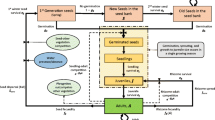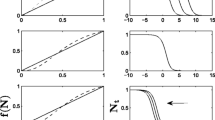Abstract
The establishment, spread and subsequent degradation of existing environments by invasive species is a worldwide problem affecting native and agricultural ecosystems. The phenomenal cost to governments as a result of research and eradication or control drives the need to understand invasion characteristics. In this paper we develop a method for modelling the boundary of an invasion over time with model inputs being the initial distribution of the invasion and the speed at which the invasion front moves over time. This speed function can depend on the topography of the ground cover and we consider examples of homogeneous and inhomogeneous spread. The possibility of a long-distance dispersal event occurring is also considered. In particular, examples of the spread of emergent weeds and weeds which favour creeks and river beds in New Zealand are presented.







Similar content being viewed by others
References
Clark J, Lewis M, Horvath L (2001) Invasion by extremes: population spread with variation in dispersal and reproduction. Am Natural 157(5):537–554
Fagan W, Lewis M, Neubert M, Aumann C, Apple J, Bishop J (2005) When can herbivores slow or reverse the spread of an invading plant? A test case from Mount St. Helens. Am Natural 166(6):669–685
Hastings A, Cuddington K, Davies K, Dugaw C, Elmendorf S, Freestone A, Harrison S, Hooland M, Lambrinos J, Malvadkar U, Melbourne B, Moore K, Taylor C, Thomson D (2005) The spatial spread of invasions: new developments in theory and evidence. Ecol Lett 8:91–101
Hogea CS, Murray BT, Sethian JA (2006) Simulating complex tumor dynamics from avascular to vascular growth using a general level-set method. J Math Biol 53(1):86–134
Lapidus L, Pinder G (1982) Numerical solution of partial differential equations in science and engineering. John Wiley and Sons Inc, USA
Leathwick R, Mc Overton J, McLeod M (2003) An environmental domain classification of New Zealand and its use as a tool for Biodiversity Management. Conserv Biol 17(6):1612–1623
Millar A (2006) Untangling spatial distribution patterns of the invasive herb Hieracium lepidulum Stenstr. (Asteraceae) in a New Zealand mountain landscape, PhD thesis, Lincoln University.
Osher S, Fedkiw R (2003) Level set methods and dynamic implicit surfaces. Springer-Verlag
Sethian J (1996) Level set methods and fast marching methods. Cambridge University Press
Shigaseda N, Kawasaki K (1997) Biological Invasions: Theory and Practice. Oxford University Press, Oxford
Wiser S, Allen R, Clinton P, Platt K (1993) Community structure and forest invasion by an exotic herb over 23 years. Ecology 79(6):2071–2081
Author information
Authors and Affiliations
Corresponding author
Appendices
Appendices
Appendix A: Formulation of a partial differential equation for the level set function ϕ(x,y,t)
We begin with the level curve specified by the implicit function
A point moving with the zero level curve can be described by x and y which can be functions of t, i.e. x = x(t) and y = y(t). Differentiation of equation (13) with respect to t gives
Using vector notation equation (14) becomes
where
Suppose that at any particular time t, a point on the zero level curve at grid location (x,y) moves with speed v(x,y,t) in the direction of the normal to the curve, i.e. in a direction perpendicular to the tangent to the curve at that point. If v > 0 then the direction is outward; if v < 0 then the direction is inward. The unit normal to the function ϕ(x,y,t) at the point (x,y) is
where
Then
Substitution into equation (15) gives
Appendix B: Numerical method for solving the level set equation
This section describes a stable numerical method for solving the level set Eq. 1. The method uses upwind finite differences to ensure that information propagates in the direction of movement of the zero level curve (Sethian 1996). The domain is discretised as x 1 , x 2 , … x i … x I , y 1, y 2, … y j … y J and t 1, t 2, … t k … t K . The numerical derivative of ϕ with respect to t can be approximated using a forward finite difference i.e.
The function value of ϕ at location (x i ,y j ) at any time t k+1 is ϕ(x i ,y j ,t k+1) and can be approximated from function values at the previous time step t k according to the equation
where ϕ x and ϕ y , the partial derivatives of ϕ with respect to x and y respectively, must be approximated using either forward or backward differences, depending on whether the curve is propagating outwards or inwards at that point. A forward difference approximation of ϕ x is denoted D + x where
A backward difference approximation is
Similarly one can derive forward and backward approximations for ϕ y as D + y and D − y respectively where
and
Recall that the direction in which the level curve is moving is given by the vector
Thus we are interested in the signs of the components of this vector. If the speed at location (x,y) and time t is positive then we look at which direction the unit normal is heading according to Table 1. For example if ϕ x < 0 and ϕ y > 0 (top-left cell of the table) then the first component of the velocity vector is negative and the second is positive, so the curve is moving in the direction of decreasing x and increasing y. Thus a forward difference should be used for ϕ x and a backward difference for ϕ y . This means that information at (x i , y j , t k+1) is based on information at (x i+1 ,y j , t k ), (x i+1, y j-1, t k ) and (x i , y j-1, t k ). Other cases are handled similarly as summarised in the table. Note that the table column and row headings can be written in terms of both the true partial derivatives (unknown) and their approximations. If v(x,y,t) < 0, the situation is the same but with the directions reversed in Table 1. All the possible cases for the signs of v, ϕ x and ϕ y can be conveniently represented as a single scheme by equations (2)–(8).
Rights and permissions
About this article
Cite this article
Basse, B., Plank, M. Modelling biological invasions over homogeneous and inhomogeneous landscapes using level set methods. Biol Invasions 10, 157–167 (2008). https://doi.org/10.1007/s10530-007-9119-8
Received:
Accepted:
Published:
Issue Date:
DOI: https://doi.org/10.1007/s10530-007-9119-8




